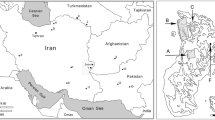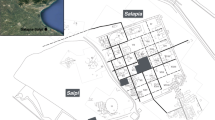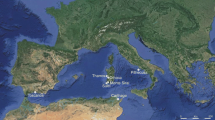Abstract
Archaeological reconnaissance in the Yemen Arab Republic produced samples of mediaeval Islamic ceramics in a 100 km2 region centred at Zabid. The ceramics dated from 700 A. D. to 1750 A. D. and initial research indicated that they were all locally made products. Twelves types of ceramics were selected for sampling on the basis of stylistic decoration; nine types were red bodied and three types were white bodied. Six laboratory samples of each type were subjected to neutron activation analysis for the short-lived isotope producing elements using the SLOWPOKE reactor at the University of Toronto. The results showed very tight sherd groupings, with all the red wares of discrete composition and all the white wares of a different discrete composition. Hence the same two clay sources have been utilized over a thousand years. However, a comparison of both ware types with Nile alluvium red ware and Aswan white ware from Egypt, tested for the same elements, produced unexpected results. Although the white wares from Egypt and Yemen were quite different chemically, the red wares showed remarkable chemical similarity. In order to subject the data to a more rigorous statistical testing, a multivariate discriminate analysis programme was applied. The analysis confirmed that the Yemeni and Egyptian white wares could easily be separated. The Yemeni red and Nile alluvium red wares were also separated into the two groups with a very high prediction rate, in spite of the fact that, on visual inspection of the data, no substantial differences were evident. It is clear, therefore, that artifact analysis must be conducted with due respect given to the archaeological context, the elemental chemistry, and sound statistical procedures.
Similar content being viewed by others
References
W. W. COOLEY, P. R. LOHNES, Multivariate Data Analysis. John Wiley and Sons, 1971.
W. J. DIXON, (Ed.), BMDP Statistical Software. University of California Press, 1983.
J. R. W. GIROLER, P. STYLES, Nature, 247 (1974) 7.
R. G. V. HANCOCK, J. Archaeol. Sci. in press.
E. J. KEALL, World Archaeology, 14 (1983) 378.
F. R. MATSON, in Science and Archaeology, R. H. BRILL, (Ed.) M. I. T. Press, Cambridge, Mass., 1971, p. 65.
N. H. NIE, C. H. HULL, Jr., G. JENKINS, K. STEINBRENNER, D. H. BENT, (Eds), SPSS User's Guide, McGraw Hill Book Company, New York, 1975.
M. A. J. WILLIAMS, H. FAURE (Eds), The Sahara and the Nile, Rotterdam, 1980.
Author information
Authors and Affiliations
Rights and permissions
About this article
Cite this article
Hallett, J., Keall, E.J., Vitali, V. et al. Chemical analysis of Yemeni archaeological ceramics and the Egyptian enigma. Journal of Radioanalytical and Nuclear Chemistry, Articles 110, 293–302 (1987). https://doi.org/10.1007/BF02055032
Received:
Issue Date:
DOI: https://doi.org/10.1007/BF02055032




